- Joined
- Oct 9, 2007
- Messages
- 47,618 (7.44/day)
- Location
- Dublin, Ireland
| System Name | RBMK-1000 |
|---|---|
| Processor | AMD Ryzen 7 5700G |
| Motherboard | Gigabyte B550 AORUS Elite V2 |
| Cooling | DeepCool Gammax L240 V2 |
| Memory | 2x 16GB DDR4-3200 |
| Video Card(s) | Galax RTX 4070 Ti EX |
| Storage | Samsung 990 1TB |
| Display(s) | BenQ 1440p 60 Hz 27-inch |
| Case | Corsair Carbide 100R |
| Audio Device(s) | ASUS SupremeFX S1220A |
| Power Supply | Cooler Master MWE Gold 650W |
| Mouse | ASUS ROG Strix Impact |
| Keyboard | Gamdias Hermes E2 |
| Software | Windows 11 Pro |
Tech Day slides leaked to the web by Kitguru provide a confirmation of how AMD is wiring out the additional two dies on the 24-core and 32-core Ryzen Threadripper 2000-series MCMs on the socket TR4 platform. We had speculated that because the quad-channel DDR4 memory and PCIe interfaces are wired to two diagonally-opposite dies on AMD X399 chipset motherboards; in the interest of backwards compatibility, AMD could wire out memory and PCIe from just two out of four dies on the multi-chip module, and have the two additional dies seek memory and PCIe over the InfinityFabric interfaces.
The obvious trade-offs with this design choice is that latencies to the dies with indirect memory/PCIe access are higher, and that reflects heavily in AMD's own performance figures for comparing the 32-core 2990WX with the 16-core 2950X from the same generation. The 2990WX is "only" up to 64 percent faster than 2950X at Cinebench R15 nT, despite having double the number of cores. To its credit, the 2950X has higher clock-speeds (3.50 GHz nominal with 4.40 GHz boost) than the 2990WX (3.00 GHz nominal with 4.00 GHz boost). The presentation also puts out interesting bits of information such as AMD's own performance numbers showing 10-15 percent performance gains between the 2950X and the 1950X; and performance gains of the 2990WX over Intel Core i9-7980XE.

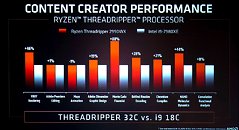
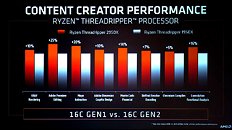
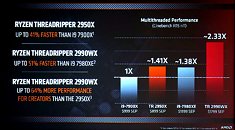
To combat problems intrinsic to MCM CPUs, which are essentially 2P-on-a-stick or 4P-on-a-stick, AMD introduced three operational modes for its Threadripper processors: Gaming Mode, Creators Mode, and Compatibility Mode. The Gaming Mode localizes less-parallelized workloads such as PC games to just one of the two/four dies, for the least memory latency. The Creators Mode makes the MCM optimized for content-creation tasks that scale with CPU and memory, by evenly spreading workloads and memory across the dies. For the 4-die MCMs, the dies with the memory/PCIe wiring are loaded first, and then additional dies are woken up. The Compatibility Mode is basically an SMT toggle. AMD demonstrated in its slides that NUMA-aware operating systems such as Windows 10 use the memory more efficiently.
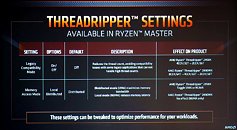
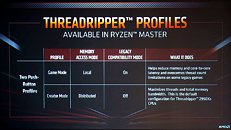
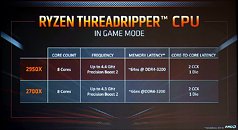
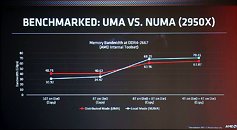
AMD also detailed the latest version of Ryzen Master software, which comes with a special UI for 32-core/24-core Threadrippers, since you now have to monitor or thinker with those many more cores. Precision Boost Overdrive (introduced with 2nd Gen Ryzen) is also available with 2nd Gen Threadrippers, giving you more control over the Precision Boost algorithm, by making it respect either power-targets, current-targets, or temperature/TDP targets.
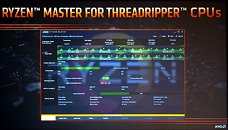

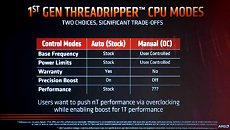
And lastly, there's a reference-design AMD Wraith series cooler for TR4. Called the Wraith Ripper, this cooler was co-designed by Cooler Master for AMD. It was unveiled at this year's Computex. It's a dual fin-stack tower (D-type in Noctua's nomenclature) heatsink, with a fan nested between the two fin-stacks, for 100% clearance with the memory areas on either sides of the socket. The cooler features an indirect-touch copper base that has full coverage of the Threadripper IHS. The cooler is capable of handling thermal loads of up to 250W, and should be able to work with the WX variants at stock speeds, or the X SKUs with mild overclocking. Its industrial design involves a plastic shroud with RGB LED diffusers running the top and sides. Cooler Master (and not AMD) will sell this cooler, at an SEP price of USD $100.
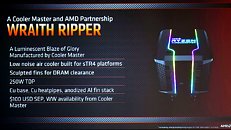
View at TechPowerUp Main Site
The obvious trade-offs with this design choice is that latencies to the dies with indirect memory/PCIe access are higher, and that reflects heavily in AMD's own performance figures for comparing the 32-core 2990WX with the 16-core 2950X from the same generation. The 2990WX is "only" up to 64 percent faster than 2950X at Cinebench R15 nT, despite having double the number of cores. To its credit, the 2950X has higher clock-speeds (3.50 GHz nominal with 4.40 GHz boost) than the 2990WX (3.00 GHz nominal with 4.00 GHz boost). The presentation also puts out interesting bits of information such as AMD's own performance numbers showing 10-15 percent performance gains between the 2950X and the 1950X; and performance gains of the 2990WX over Intel Core i9-7980XE.




To combat problems intrinsic to MCM CPUs, which are essentially 2P-on-a-stick or 4P-on-a-stick, AMD introduced three operational modes for its Threadripper processors: Gaming Mode, Creators Mode, and Compatibility Mode. The Gaming Mode localizes less-parallelized workloads such as PC games to just one of the two/four dies, for the least memory latency. The Creators Mode makes the MCM optimized for content-creation tasks that scale with CPU and memory, by evenly spreading workloads and memory across the dies. For the 4-die MCMs, the dies with the memory/PCIe wiring are loaded first, and then additional dies are woken up. The Compatibility Mode is basically an SMT toggle. AMD demonstrated in its slides that NUMA-aware operating systems such as Windows 10 use the memory more efficiently.




AMD also detailed the latest version of Ryzen Master software, which comes with a special UI for 32-core/24-core Threadrippers, since you now have to monitor or thinker with those many more cores. Precision Boost Overdrive (introduced with 2nd Gen Ryzen) is also available with 2nd Gen Threadrippers, giving you more control over the Precision Boost algorithm, by making it respect either power-targets, current-targets, or temperature/TDP targets.



And lastly, there's a reference-design AMD Wraith series cooler for TR4. Called the Wraith Ripper, this cooler was co-designed by Cooler Master for AMD. It was unveiled at this year's Computex. It's a dual fin-stack tower (D-type in Noctua's nomenclature) heatsink, with a fan nested between the two fin-stacks, for 100% clearance with the memory areas on either sides of the socket. The cooler features an indirect-touch copper base that has full coverage of the Threadripper IHS. The cooler is capable of handling thermal loads of up to 250W, and should be able to work with the WX variants at stock speeds, or the X SKUs with mild overclocking. Its industrial design involves a plastic shroud with RGB LED diffusers running the top and sides. Cooler Master (and not AMD) will sell this cooler, at an SEP price of USD $100.

View at TechPowerUp Main Site




